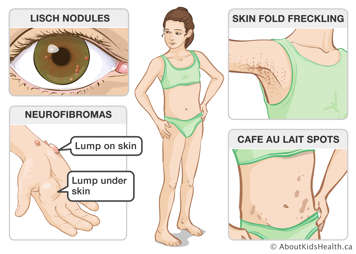Most children with neurofibromatosis type 1 (NF1) (say: noor-oh-fie-broh-muh-TOE-sis) live long and healthy lives. There is no cure for NF1, but proper monitoring can lead to early identification of complications, and intervention where possible.
Common complications of NF1
Here are some of the complications that can occur with NF1. People with NF1 may only develop one or two of these complications. It is very unlikely that a person with NF1 would develop many or all of the complications listed here.

Neurofibromas
Neurofibromas are benign, soft tumours that involve cells that surround the nerves. Benign means they are not cancerous. There are two types of neurofibromas: cutaneous (skin) neurofibromas are small bumps on the surface of the skin; subcutaneous (under the skin) are small lumps under the skin that are often hard. Neurofibromas develop over time throughout the life span. Neurofibromas usually do not need to be removed and can be difficult to remove. Removal may be considered in special circumstances.
Plexiform neurofibromas
Plexiform neurofibromas are benign tumours that involve cells that surround the nerves. They may appear near the surface of the skin or may lie deep in the body. Sometimes they grow to a large size, but usually do not cause any harm to the child's health. Plexiform neurofibromas usually do not need to be removed and can be difficult to remove. Removal may be considered in special circumstances.
New treatments are being studied. In very rare cases, plexiform neurofibromas may become a cancerous tumour called a malignant peripheral nerve sheath tumour.
Optic pathway gliomas
The optic nerve is the nerve that connects the back of the eyeball to the brain. When this nerve becomes enlarged, it is called an optic nerve glioma. This occurs in about 15% of children with NF1. However, in most cases (85%), an optic nerve glioma will not cause any problems with the child's sight or health, and is considered asymptomatic (not causing symptoms) and requires monitoring with eye examinations and MRI. Some children with NF1 have symptomatic optic nerve gliomas and these may require treatment with chemotherapy and/or surgery.
Bony changes and scoliosis
If your child has NF1, the doctor will check their spine (backbone) once a year. If there are abnormalities, the doctor will take an X-ray of your child's back. If scoliosis is confirmed on X-ray, your child may be referred to a bone specialist (orthopaedic surgeon). If the scoliosis is mild, this may require monitoring with X-rays and physical examinations as the scoliosis may progress as the child gets older. Treatment for high-grade scoliosis may include wearing a back brace and/or surgery.
Learning difficulties
Learning difficulties are more common in children with NF1. If there are concerns about how well your child is doing in school, or if your child shows signs of hyperactivity or attention problems, your child may benefit from a psycho-educational assessment. You may wish to request a psycho-educational assessment from your child's school principal. These assessments are conducted by highly trained educational psychologists using standardized testing to assess children's intelligence, learning, grade level, memory, behavior and other aspects of learning. Results of these assessments may lead to specialized recommendations for your child's classroom placement, such as the development of an Individual Education Plan (IEP). Some children with NF1 have features of Attention Deficit Disorder, with or without Hyperactivity and may benefit from medication. Some children with NF1 have features of social skills difficulties, autism or Asperger's and may benefit from specialized therapy.
Other complications
Other, less common complications of NF1 include:
- seizures
- increased fluid surrounding the brain (hydrocephalus)
- early (precocious) puberty
- narrowing of the artery that supplies blood to the kidney (renal artery stenosis)
- congenital heart defects
- narrowing of an artery in the brain (Moyamoya disease)
These are uncommon, but need attention from a specialist.
If you have any questions about treating NF1 in your child, talk to their doctor.
Troublesome symptoms of NF1: When to call the doctor
If your child has any of the following symptoms, contact their doctor:
- long-lasting or recurring pain, or pain that wakes your child up or keeps them awake at night
- numbness, tingling or weakness in an arm or leg
- changes in neurofibromas, such as persistent and continuous pain, rapid increases in size or hardening
- problems with vision or bulging of the eyeballs
- new, lasting or changing headaches